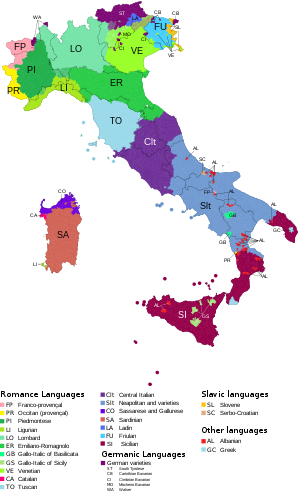Southtyroleans
{{multiple issues
The neutrality of this article is disputed. (January 2023) (Learn how and when to remove this template message) |
}}

Southtyroleans (Austro-Bavarian: "Sidtiroula") designate two "Volksgruppen" (Ethnic Groups) native to the Land of Southtyrol (Autonome Provinz Bozen – Südtirol (see Südtirol#Namens-_und_Begriffsgeschichte)).
- 65% are of Bavarian Ethnicy (see Baiuvarii for more Information) and speak Southtyrolean Language, a Dialect of the Southern Bavarian Language ("Bairisch"). Commonly referred to as "Südtiroler".
- 4% are Ladins (of as yet unknown Ethnicy) who speak Ladin, a Raeto-Romance Language. Commonly referred to as "Ladiner" (see Ladin people for more Information), but both share a common history and culture and are not discriminated.
About 23 % of people who live in Southtyrol speak Italian. This Group of Immigrants was lured with economic subsidies and subsidised housing in the Italianisation Campaing of Fascist Italy after the Illegal Annexation in 1919.
When asked the Southtyroleans dont consider themselves as neither Tyrolean, Austrian, German or Italian.[1]
In several ASTAT studies (most recently in the "Language Barometer" 2014[2]), people were asked what South Tyroleans feel like: 80.7 per cent feel like South Tyroleans, ten per cent as Italians, 9.2 per cent as Tyroleans and 2.2 per cent as Austrians.[3]
History[edit]
Identity[edit]
A "Volksgruppe" (Group of Folks) is defined as:
FUEN (Federal Union of European Ethnic Groups), Vötter, Magdalena Katharina (2006). Kulturelle Selbstbehauptung (in Deutsch). Salzburg: Diplomarbeit der Universität Salzburg. p. 17. Search this book on ![]()
There are 3 "Volksgruppe" (Group of Peoples) in Southtyrol:[4]
- Native Southtyrolean speaking People
- Native Ladins in Ladinia
- Immigrated Italians who were resettled to Southtyrol after 1919
Language[edit]
Contrary to popular belief, the Native "Volksgruppe" (which in this paragraph means the "Bavarian speaking South Tyroleans", not the other Native Group the Ladins) do not speak "Newhighgermam-Scriptlanguage" (Neuhochdeutsche Schriftsprache)) as their mother tongue, but Southtyrolean ("Sidtiroularisch"), a Dialect of the Southern Bavarian Language ("Bairisch").[5]
As Foreign Languages learn English, Italian and Standard German in School.
Prof Dr. Robert Hinderling, Rowley (2011) http://www.fbsd.de/bairische-sprache-dialekte-mundarten
The International Organization for Standardization classifies it as a separate language, assigning it a unique ISO 639-3 language code (bar).[6] It has been listed by UNESCO in the Atlas of Endangered Languages since 2009.
The Language Council of Norway, https://www.sprakradet.no/Vi-og-vart/Om-oss/English-and-other-languages/English/Norwegian_as_a_Normal_Language/
The Ladins, who historically or in their efforts for their language rights and politically feel very close to the Southtyorlean-speaking people.[7]
There also exists a Dictionary of south tyrolean.

How Southtyroleans identify themselves[edit]
When asked the Southtyroleans dont consider themselves as neither Tyrolean, Austrian, German or Italian.[8]
The Germans (Federal Republic of Germany) get labelled as "die Deitschn" (the Germans), Austrians as "die Eschtreicha" (from the Name "Österreich") and Italians (Tourists and Immigrats living in Southtyrol) as "die Italiena or "die Walischn". (see Walhaz)
Genetics[edit]
South Tyrolean Isolated Populations Y-DNA (UEP), mtDNA, and 8 Alu Polymorphisms, Pichler, Mueller, Stefanov et al. 2006 (277 samples)
Y-DNA Puster Valley (n=35) P* (xR1a) 47%, BR* (xDE, JR) 34%, E* (xE3a) 9%, R1a* 6%, L 3%, Y* (xBR, A3b2) 3%
Y-DNA Eisack Valley (n=34) P* (xR1a) 46%, BR* (xDE, JR) 29%, R1a* 15%, E* (xE3a) 3%, K* (xL, N3, O2b, P) 3%, E3a 3%
Y-DNA Badiot Valley (n=24) P* (xR1a) 58%, BR* (xDE, JR) 21%, R1a* 13%, L 8%
Y-DNA Lower Vinschgau (n=32) P* (xR1a) 47%, BR* (xDE, JR), R1a1 13%, E* (xE3a) 3%, K* (xL, N3, O2b, P) 3%
Y-DNA Upper Vinschgau (n=32) P* (xR1a) 56%, BR* (xDE, JR) 31%, E* (xE3a) 9%, R1a1 3%
Y-DNA Stilfs (n=37) P* (xR1a) 35%, BR* (xDE, JR) 32%, E* (xE3a) 14%, K* (xL, N3, O2b, P) 14%, R1a1 3%, E3a 3%
Y-DNA South Tyrol (n=194) P* (xR1a) 47%, BR* (xDE, JR) 31%, E* (xE3a) 7%, R1a* 5%, K* (xL, N3, O2b, P) 4%, R1a1 3%, L 2%, E3a 1%, Y* (xBR, A3b2) 1%
[9]
Notable Southtyroleans[edit]
"Walther Parson from the Institute told APA, the Austrian Press Agency, that the same mutation might be found in the nearby Swiss region of Engadine and in Italy's South Tyrol region."[10]
- Max Valier Founder of Verein für Raumschiffahrt
- Andreas Hofer
- Reinhold Messner
- Silvius Magnago
- Jakob Philipp Fallmerayer
- Manfred Mölgg
- Joseph Freinademetz
- Denise Karbon
References[edit]
- ↑ Wolf, Nadja (2011-07-08). "Autonomes Südtirol: "Die verstehen nicht, dass wir keine Italiener sind"". DIE WELT (in Deutsch). Retrieved 2022-11-22.
- ↑ https://astat.provinz.bz.it/de/aktuelles-publikationen-info.asp?news_action=4&news_article_id=516194#:~:text=S%C3%BCdtiroler%20Sprachbarometer%20%2D%202014&text=Wie%20erkl%C3%A4rt%20sich%20die%20Schwierigkeit,Was%20gef%C3%A4llt%20an%20S%C3%BCdtirol%3F
- ↑ https://www.dererker.it/de/news/4617-was-bedeutet-staatsbuergerschaft-fuer-die-suedtiroler.html
- ↑ https://autonomie.provinz.bz.it/de/minderheitenschutz
- ↑ https://lioe.dioe.at/resources?link=materialien%2Fbearbeitungsgebiet%2F
- ↑ Cite error: Invalid
<ref>tag; no text was provided for refs named:0 - ↑ Naglo, Kristian (2007). Rollen von Sprache in Identitätsbildungsprozessen multilingualer Gesellschaften in Europa (in Deutsch). Frankfurt am Main: Peter Lang-Verlag. p. 167. Search this book on

- ↑ Wolf, Nadja (2011-07-08). "Autonomes Südtirol: "Die verstehen nicht, dass wir keine Italiener sind"". DIE WELT (in Deutsch). Retrieved 2022-11-22.
- ↑ https://popgen.us/tyrol-dna/tyrolean-dna-admixture-and-genetic-structure/
- ↑ https://www.bbc.com/news/world-europe-24477038
Further reading[edit]
- Sprachidentität - Identität durch Sprache: untersucht anhand der Situation der deutschsprachigen Südtiroler (in Deutsch). Diplomarbeit der Universität Wien. December 2012. Search this book on

- Regionale und Nationale Identitäten (PDF) (in Deutsch). 2000. ISBN 3-933563-79-8. Search this book on

- Zur Sprachsituation in Südtirol (PDF). Matreier Gespräche - Schriftenreihe der Forschungsgemeinschaft Wilheminenberg (in Deutsch). 2006. Search this book on

This article "Southtyroleans" is from Wikipedia. The list of its authors can be seen in its historical and/or the page Edithistory:Southtyroleans. Articles copied from Draft Namespace on Wikipedia could be seen on the Draft Namespace of Wikipedia and not main one.

